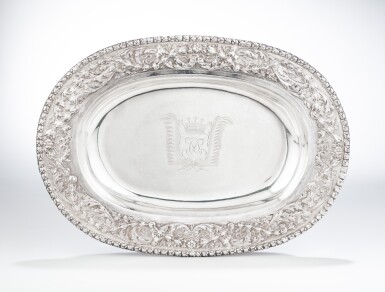
A Charles II silver dish, John Cooqus, London, 1683
Estimate
30,000 - 50,000 EUR
Lot Details
Description
oval, the rim applied with band of running flower buds, the wide border chased and embossed with scrolling acanthus, foliate garlands, flowerheads, fruit and ribbons against matte ground, the center engraved with an earl's coronet above a double cypher CT flanked by ribbon-tied palm fronds, fully marked on border,
48,5 cm., 19in.
1520gr., 48¾oz
Catherine Tufton, by descent to her daughter,
Mary Tufton, 3rd wife of John Leveson Gower, 1st Earl Gower, 1736,
Christie's, 28 June 1916, lot 19, purchased by,
Crichton & Sons,
Airlie Holden Hindley, circa 1975,
Albert Collection,
Sotheby’s, New York, 13 May 2007, lot 132,
SJ Shrubsole, New York, 2020
Brand Inglis, July 1978, no. 11.
B. Inglis; The Arthur Negus Guide to British Silver; p. 64, pl. 70.
R. Butler; The Albert Collection, Five Hundred Years of British & European Silver; London; 2004; p. 103.
A. Grimwade; New Light on the English Royal Plate; The Silver Society Journal, No 7 (1995) (a), pp.369-380
According to Butler's catalogue of the Albert Collection, the cypher is that of Countess Catherine Tufton (1665-1712), daughter of Henry Cavendish, 2nd Duke of Newcastle, and wife of Thomas Tufton, 6th Earl of Thanet, whom she married at Welbeck on 14 August 1684.
This dish would have been part of a larger toilet service, which was considered a customary wedding gift in the latter half of the 17th century. These services were generally presented to the bride by her husband, and thus bear the wife's arms or cypher. As the date of this dish closely corresponds to the couple's marriage and as it is engraved with the Countess' cypher, it is assumed to have been a wedding gift from Thomas Tufton to Catherine Cavendish. This dish displays the French-style decoration popular in Court circles after the return of Charles II. A similar basin with accompanying ewer, with putti amongst the foliage, belonged to William Lockhart, ambassador to Louis XIV. Considered Parisian work of about 1656, it is now in the collection of the Fitzwilliam Museum, Cambridge (illustrated Michèle Bimbenet-Privat, Les Orfèvres et L'Orfèvrerie de Paris au XVIIe siècle, vol.1, p. 187). Another foliate-edged oval basin of French manufacture forms part of the toilette service with the arms of Mary of England and Prince William of Orange, presumably presented on their marriage in 1677 (Duke of Devonshire collection, Chatsworth).
John Cooqus (Cockus) was the son-in-law of Christian van Vianen, from the famous family of Utrecht goldsmiths, who had come to England to work for Charles I. Cooqus was appointed 'Silversmith in Ordinary to his Mjtie for chastwork within His Majesty's Closett and Bedchamber' in 1661, and in 1664 he was commissioned to make a silver bed for Nell Gwynne, the king's mistress; the total weight of silver used for this extraordinary but sadly no longer extant creation was 2,265oz. He worked in London until his death in 1697.
You May Also Like










